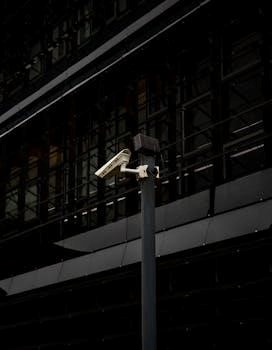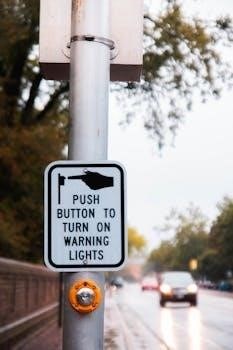Installing a 2-post lift, like the Kernel TP9KAX, involves setting up, anchoring, and assembling. It’s crucial to read the installation manual thoroughly before starting. This guide provides essential safety instructions and step-by-step procedures for successful installation.

Safety Precautions Before Installation
Before installing any 2-post lift, prioritize safety. Read the owner’s manual completely. Anyone near the lift should understand safety guidelines. Ensure the area is clear and use proper safety equipment during the installation process.
Reading the Manual
Prior to commencing any work on the 2-post lift installation, a comprehensive review of the provided manual is absolutely essential. This manual serves as the primary source of information regarding safety protocols, proper installation techniques, and operational guidelines specific to the lift model being installed. Neglecting to thoroughly read and understand the manual can lead to serious safety hazards, incorrect installation procedures, and potential damage to the equipment or the surrounding environment.
The manual will outline critical aspects such as load capacity, voltage requirements, and recommended maintenance schedules. It is crucial to pay close attention to all warnings and cautions detailed within the manual, as these are designed to prevent accidents and ensure the safe operation of the lift. Familiarize yourself with all diagrams, illustrations, and step-by-step instructions provided to ensure a smooth and successful installation process.
Necessary Safety Equipment
Safety is paramount when installing a 2-post lift, demanding the use of appropriate safety equipment. Eye protection, such as safety glasses or goggles, is crucial to shield against flying debris during drilling and anchoring. Heavy-duty work gloves are essential to protect hands from cuts and abrasions while handling metal components and tools. Steel-toed boots safeguard feet from potential impacts and heavy objects.
A hard hat provides head protection against falling objects in the work area. Ear protection, like earplugs or earmuffs, is recommended to mitigate noise exposure from power tools. Ensure a first-aid kit is readily available for minor injuries. A properly rated respirator may be needed if welding or working with materials that generate fumes. Following these safety guidelines ensures a safer installation environment.

Pre-Installation Requirements
Before installing a 2-post lift, ensure your floor meets minimum thickness and PSI standards. Confirm you have the correct voltage, typically 220V, available. These steps ensure safe and proper lift operation.
Floor Requirements⁚ Thickness and PSI
Before commencing the 2-post lift installation, verifying the floor’s suitability is paramount. The concrete floor must possess a minimum thickness of 4 inches (102mm) to ensure adequate support for the lift and vehicles. Additionally, the concrete needs a compressive strength of at least 3000 psi (20.7MPa) to withstand the load.
It is essential that the concrete has been aged for a minimum period as specified by the manufacturer, allowing it to achieve its designed strength. Furthermore, the floor should be level to ensure proper lift operation and prevent uneven stress on the structure. Failure to meet these requirements can compromise the lift’s stability and safety.
Voltage Requirements⁚ 220V Considerations
When installing a 2-post lift, understanding the voltage requirements is crucial for proper operation. Many lifts, especially those designed for heavier loads, often require a 220V power supply. Before purchasing or installing a lift, it’s essential to check the available voltage at the installation site.
If a 220V outlet is not readily available, hiring a qualified electrician to install one becomes necessary. This ensures the lift receives the correct power for safe and efficient operation. Operating a lift with insufficient voltage can lead to performance issues and potential damage to the equipment. Always verify voltage compatibility before proceeding.

Step-by-Step Installation Guide
This section outlines the installation process, beginning with positioning the posts correctly. Next, securely anchor the posts to the concrete floor. Finally, assemble the top plate, arms, and cables according to the manual.
Positioning the Posts
Begin by laying down both posts parallel to each other at the intended installation site. Carefully determine the location of the power side post, considering the surrounding environment and accessibility. Reference figures in the manual, such as Fig. 18 for the BP8000 model and Fig. 19 for the BP9000 model, to ensure proper orientation.
The “Car-in direction” should be clearly identified to ensure the power side post and offside post are correctly positioned. Accuracy in this step is critical, because it directly affects the lift’s functionality and the vehicle’s safe and efficient operation. The subsequent assembly of the top plate, using M1035 Hex Bolts with Nuts and Spring Washers, depends on this precise positioning.
Anchoring the Posts
Properly anchoring the posts is a critical step to ensure the lift’s stability and safety. The concrete floor must meet the minimum requirements of 4 inches in thickness and 3000 PSI compressive strength. Use appropriate anchor bolts designed for this purpose, following the manufacturer’s instructions precisely.
Drill the holes according to the specified depth and diameter, ensuring they are perpendicular to the floor. Clean the holes thoroughly to remove any debris before inserting the anchors. Tighten the anchor bolts to the recommended torque to secure the posts firmly to the concrete. This step is essential for preventing movement or instability during lift operation. Verify the anchors’ tightness periodically after installation.
Assembling the Top Plate/Overhead Beam
The top plate or overhead beam connects the two posts, providing structural integrity and cable routing for overhead lifts. Carefully lift the top plate into position, aligning it with the mounting points on each post. Secure the top plate using the specified bolts, nuts, and washers, typically M10x35 hex bolts with spring washers.
Ensure all fasteners are tightened to the manufacturer’s recommended torque. Double-check the alignment to confirm the posts are square and plumb. The top plate must be level to ensure smooth and safe operation of the lift. This assembly step is crucial for the lift’s overall stability and functionality. Carefully inspect the connections after initial use.
Installing Arms and Cables
Begin by attaching the swing arms to the lift carriages, ensuring they are properly aligned and secured. Use the appropriate pins, bolts, or locking mechanisms as specified in the manual. Next, route the cables through the designated pulleys and sheaves within the lift’s structure. Ensure the cables are free from kinks or twists.
Connect the cable ends to the carriages and equalization system, adjusting the tension as needed. Verify that the arms swing freely and lock securely in various positions. Double-check all connections to prevent slippage or detachment during operation. Proper cable tension is critical for synchronized lifting and lowering. The cables must be properly seated in the pulleys.
Post-Installation Checks
After installation, thoroughly test the lift mechanism through its full range of motion. Conduct a comprehensive safety inspection, verifying all components are secure and functioning correctly. Refer to the manual for specific checks.
Testing the Lift Mechanism
Once the 2-post lift is fully installed, meticulously test its lifting mechanism. Begin by performing several up and down cycles without any load, closely observing for smooth and consistent operation. Listen for unusual noises, such as grinding, clicking, or popping sounds, which could indicate potential issues with the hydraulic system or mechanical components. Ensure that the lift rises and lowers evenly, maintaining a level platform throughout its range of motion.
Carefully examine the locking mechanisms at various heights to confirm they engage securely and disengage smoothly. Verify the safety locks function correctly and can effectively prevent the lift from descending unexpectedly. Pay close attention to the cables and hoses, checking for any signs of leaks, kinks, or damage. If any irregularities are detected, immediately cease testing and address the problem before proceeding further. Consult the manufacturer’s manual for troubleshooting guidance and recommended solutions.
Safety Inspection
Following the lift mechanism testing, conduct a thorough safety inspection. Begin by visually inspecting all welds, bolts, and connections to ensure they are secure and properly tightened. Verify that all safety labels and warnings are clearly visible and legible. Examine the swing arms for any signs of damage, such as cracks or bending, and ensure they move freely and lock securely into place.
Confirm that the safety locks engage properly at all designated locking positions, preventing accidental descent. Inspect the hydraulic hoses and fittings for leaks, wear, or damage, and replace any compromised components. Ensure the power unit operates smoothly and efficiently, without any unusual noises or vibrations. Double-check that the emergency stop button functions correctly, immediately halting the lift’s operation when pressed. Document the inspection findings and address any identified issues before using the lift. Regularly scheduled safety inspections are crucial for maintaining a safe working environment.

Maintenance and Operation
Regular inspections are crucial for safe 2-post lift operation. Adhere to usage guidelines and address any issues immediately. Proper maintenance ensures longevity and prevents accidents, promoting a safe work environment.
Regular Inspections
Consistent and thorough inspections are paramount for maintaining the safety and operational efficiency of your 2-post lift. These checks should encompass all critical components, including the lift arms, cables, and safety locks. Look for signs of wear, damage, or corrosion, and address them promptly. Regularly inspect the hydraulic system for leaks and ensure that all moving parts are properly lubricated.
A comprehensive inspection schedule not only extends the lifespan of your lift but also minimizes the risk of accidents or equipment failures. Keep a detailed log of all inspections, noting any findings and the corrective actions taken. This proactive approach ensures a safe and reliable lifting operation.
Proper Usage Guidelines
To ensure the safe and effective operation of your 2-post lift, adherence to proper usage guidelines is essential. Always consult the lift’s manual for specific weight limits and recommended lifting points for various vehicles. Position vehicles carefully on the lift, ensuring balanced weight distribution.
Never exceed the lift’s maximum capacity, and always use the safety locks at appropriate intervals during lifting and lowering. Train all operators on the lift’s operation, safety features, and emergency procedures. Regularly inspect the lift for any signs of damage or wear, and promptly address any issues. By following these guidelines, you can maximize the lifespan of your lift and minimize the risk of accidents.



